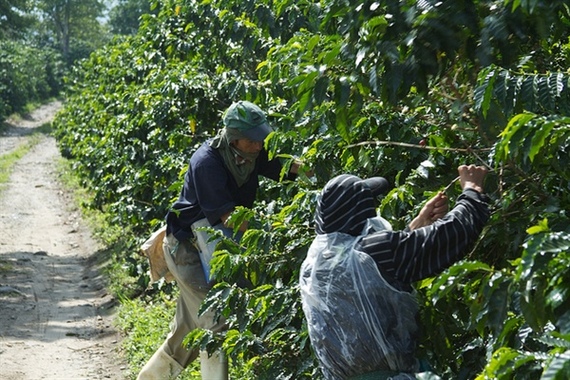By Tomas Miller and Verónica Trujillo

Tomas Miller joined the Multilateral Investment Fund in 2000 and heads its Access to Finance Unit, overseeing a loan and equity portfolio related to microfinance, venture capital, early-stage equity, small business financing, and financial services for low-income people.
How are financial inclusion and productivity linked? And why are these two pieces of the puzzle important for the economic development of Latin America and the Caribbean?
Insufficient growth in productivity has been identified as a key factor in the relative backwardness of the economy of Latin America and the Caribbean compared with other regions of the world. Among the factors that limit productivity are large numbers of informal businesses; shallow credit markets; and a lack of investment in science, technology, and innovation. Increased productivity in the countries of the region is essential to generate greater prosperity for its citizens, and to encourage economic growth despite the current unfavorable international economic environment.
Meanwhile, financial inclusion--conceptualized and analyzed from a multidimensional perspective--has been identified as an important factor in economic growth and in the stability of financial systems, and can have positive impacts on issues like inequality and poverty.
Financial inclusion goals should be aligned with increased productivity goals
Financial inclusion initiatives seek to address the factors that stifle productivity. Globally, the goals of financial inclusion strategies include access to microcredit for formal and informal entrepreneurs, easier access to credit for small and medium-sized enterprises, and increasing the number of people with savings accounts, thereby boosting national savings.
How then to promote financial inclusion in order to boost productivity? The answer is to identify how best to reach segments of the population until now excluded from the formal financial system, with financial products and services that empower them and allow them to become players in their local economy. This implies financial products that are designed to facilitate investments, either directly (credit, factoring, leasing, or any other product that finances business activities), or indirectly (through savings that make funds available to banks, which they can in turn use for credit, factoring, etc.).
Financial institutions and entities that are supplying financial services based on new technologies (Fintech) should develop new and innovative distribution channels and appropriate financial services for young entrepreneurs, women, and micro, small and medium-sized enterprises. In this way, financial inclusion also contributes to social inclusion.
For example, Banco de Bogota, in partnership with the Federación Nacional de Caficultores de Colombia [National Network of Coffee Producers of Colombia], has provided specifically designed services to more than 300,000 producers, giving them access to a range of financial services and reducing their costs: an ID that also functions as a debit card, transaction savings accounts, and access to ATMs and online banking. The partnership also has provided financial education for the coffee farmers, and set up a Red Cafetera [Coffee Maker Network] program that allows the producers to sell their beans to 38 cooperatives that have 480 points of sale throughout Colombia. The producers benefit in several ways. For example, the payments from the cooperatives go directly to the producers' accounts with Banco de Bogota. The convenient market for their beans reduces their transportation costs and their transactional costs.
If policies to promote financial inclusion are to succeed, they must be coordinated, taking into account the potential impacts of each policy on the objectives of growing the economy, reducing inequality, and lowering still-high levels of poverty in Latin America and the Caribbean. In economies that are growing at a slower pace, the public sector must design financial inclusion policies that don't pose risks to the financial system or to consumers who are inexperienced in the use of financial services.
The state of financial inclusion in Latin America and the Caribbean
Recent data speak to the need for further progress in terms of the depth and reach of financial systems in the region. Latin America and the Caribbean has:
- A low ratio of credit to GDP. This is around 40% in the region, which is mostly described as upper middle income. In comparison, the percentage in peer countries globally is about 90%, and in lower-middle-income economies like India it exceeds 50% (World Development Indicators, 2014)
- Limited reach of financial services. Regional data indicate that levels of penetration in typically excluded segments are still very low. For example, agricultural credit represents around 5% of total loans in the formal financial system, while the rural population exceeds 20% of total population. Also, the number of microcredit borrowers represents only about 20% of total informal businesses in the region.
- Low levels of domestic savings. Recent studies indicate that domestic savings precedes investment, and to increase the current levels of investment, the region must increase its domestic savings so that it is not dependent on the volatility of foreign investment.
- A credit gap for small businesses. The size of the financing gap for small and medium-sized enterprises may reach230 billion.
- Underserved groups whose financial needs are growing. The population that forms the base of the economic pyramid (70% of the total population) is growing and their income is increasing, and it is expected that by 2020, 16% of this segment will have migrated to the middle class and require more financial services. Future generations of youth are expected to be more educated and healthier, which over time will give them more disposable income and therefore more financial needs (investments, insurance, pensions, and so on). Yet today, only 37% of people under age 24 have accounts at a formal financial institution, and only 11% have savings in formal institutions (Global Findex 2014). The trend is similar for women, who are expected to continue increasing their participation in the workforce and the economy. However, nowadays only 45% of women have an account at a financial institution, and fewer than 10% have borrowed from one (Global Findex 2014).
Verónica Trujillo
Verónica Trujillo works for the Multilateral Investment Fund's Access to Finance unit on issues of financial system regulations and financial inclusion policies and data. She has a PhD in economics from the University of Salamanca in Spain, where she specialized in regulation of microfinance.
From the Multilateral Investment Fund Trends blog
